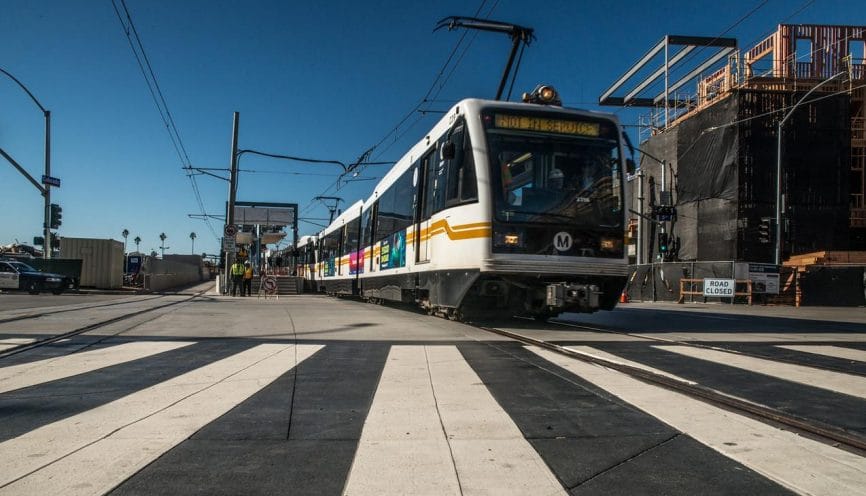
The Internet has been abuzz recently over the recent L.A. Times article, “Billions spent, but fewer people are using public transportation in Southern California.”
The responses were myriad, with people discussing the many reasons why L.A. County public transit ridership might be down. Joe Linton at Streetsblog L.A. has a pretty comprehensive list of the responses in addition to his own take.
There are a lot of factors that could be contributing to a decline in Metro ridership: national trends, lower gas prices, public investment patterns that still tremendously favor personal vehicle infrastructure over public transit, and loss of bus service to name a few.
Another big problem? Resistance to growth near major transit hubs.
On the penultimate episode of KCRW’s “Which Way L.A.,” Brian Taylor, director of UCLA’s Lewis Center for Regional Policy Studies, tackled the issue of declining public transit ridership along with Move L.A. Director Denny Zane, a former Santa Monica City Council member, among other things. The segment begins at the 4 minute, 42 second mark.
Zane noted that while ridership may be down at the moment, the system is still being built out. Projects like Expo Line phase II, which will connect Downtown Santa Monica to Downtown L.A. once it opens in May, will likely help boost ridership once they are built out, he said.
While that might be true, Taylor pointed out that there are a variety of public policies — like minimum parking requirements — that encourage people to choose driving over taking public transit.
Then, there is the question of transit-oriented growth. One key to getting people to use more transit is to locate more homes and jobs conveniently near high-quality transit hubs. Santa Monica is about to get three fixed-rail stations once the Expo lines opens up later this year, but there has been significant push back against transforming the areas around those stations — two of which are located in formerly industrial parts of town — into mixed-use neighborhoods.
“There isn’t a lot of agreement about how to proceed, what sort of development patterns we can agree on,” Taylor said. “You see, in Santa Monica, there’s big fights about whether density should be increased and whether we should do more to improve transit and increase walking and biking.”
Zane claimed that the opposition to such projects was that they were “high-end” market rate projects. Zane said that Metro’s “core ridership is the low-income workforce” and as such, he said, the developments near transit should include “significant low-income people.”
Zane, who is co-chair of the city’s single-most influential political organization, Santa Monicans for Renters’ Rights (SMRR), was a vocal opponent of the ill-fated Bergamot Transit Village and joined forces with no-growth group Residocracy to defeat the proposed mixed-use project proposed for the former Papermate factory site across the street from the 26th Street Expo station. SMRR solidified its alliance with Residocracy early this year when the organization appointed Residocracy advisory board member Ed Hunsaker to its steering committee.
Zane neglected to mention that the Bergamot Transit Village would have had nearly 100 apartments in it that would have been required, as part of an agreement with the city, to rent below market rate rents. The city had negotiated for a significant number of those to be rented to low-income seniors.
Zane’s comments ring even less true when you take into account that every major new market-rate development in Santa Monica is required by the city charter to set aside a certain percentage of units to rent at below-market rates to lower-income tenants as part of the city’s Affordable Housing Production Plan. Because the affordable housing requirements are a percentage of units built, the more apartments a developer builds overall, the more units are available for “the low-income workforce.”
The private-public partnership model for affordable housing development in Santa Monica is especially important now after the city saw its main source for public funding for affordable housing dry up with the dissolution of redevelopment agencies in 2012.
On top of fighting the Bergamot Transit Village project, the City Council last year narrowly voted to significantly scale back the zoning capacity on the city’s major commercial boulevards, many of which are within walking or biking distance of major transit stops, that would have allowed for four-to-five-story mixed-use apartments.
Santa Monica is a major job center, but it hasn’t seen much new housing built in the past three decades. Since 1980, Santa Monica has only built enough housing to allow for about a 4,100-person net increase in its residential population.
While Santa Monica alone isn’t causing the drop-off in Metro’s ridership, it is contributing to a systemic problem in the region by resisting updates to its land use patterns to better integrate with a changing transportation network. In light of the gravity of the region’s housing shortage, and the skyrocketing rents that have resulted, Metro has made strides to develop some of the land it owns near hubs with affordable housing.
In an interview with Santa Monica Next last year, Ethan Elkind, author of Railtown, spelled out the problem:
“It’s a drag on taxpayers to have to pay for underperforming rail lines. It’s a drag when you don’t have enough riders, and what generates riders are the jobs and housing around the transit stations,” he said. “If locals don’t allow the jobs and housing to come in, then they are basically telling everyone else to pay for their small group of residents and commuters to have access to a fancy rail line. And, yet, they aren’t willing to make the changes necessary to make the rail line a cost-effective investment.”
